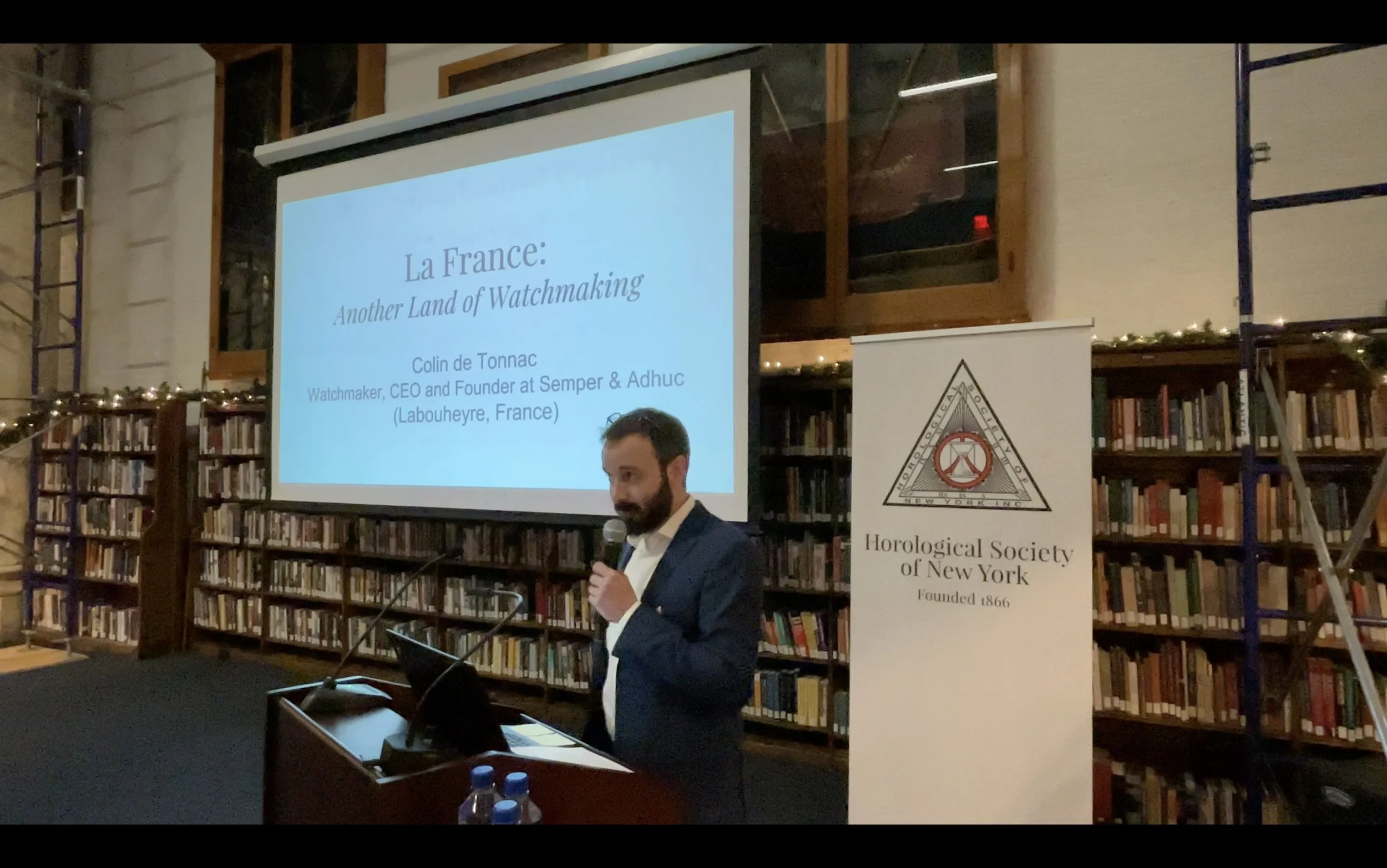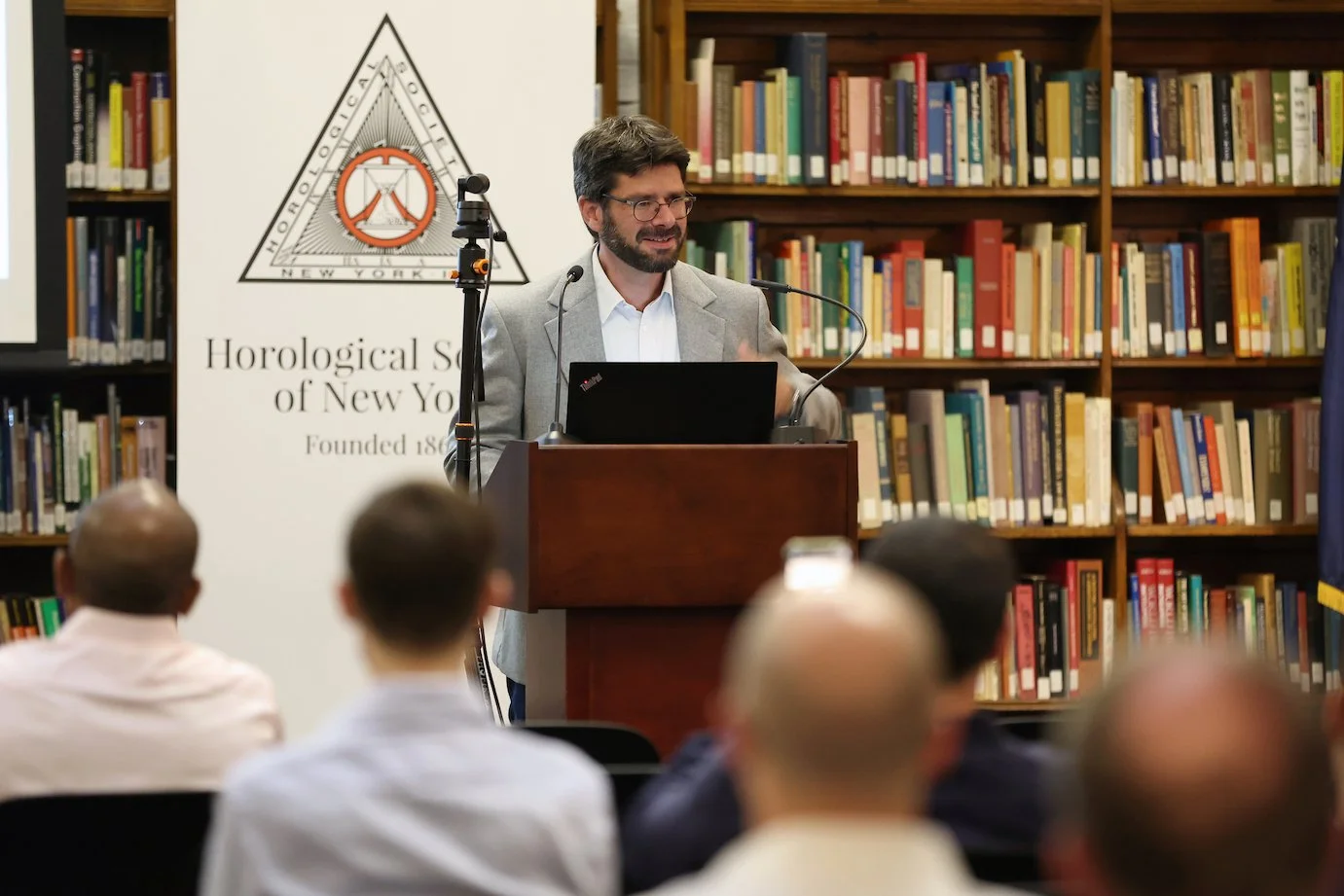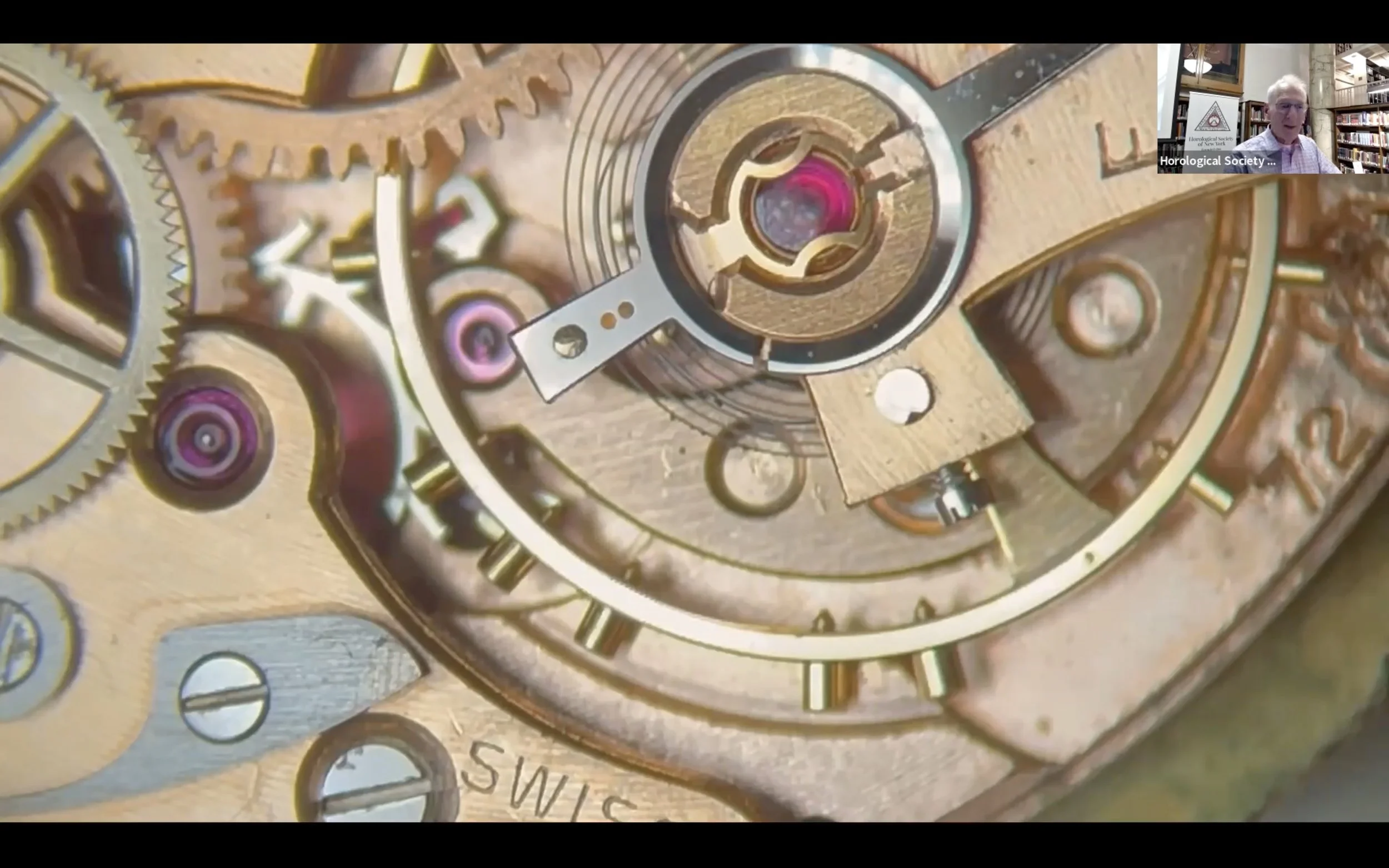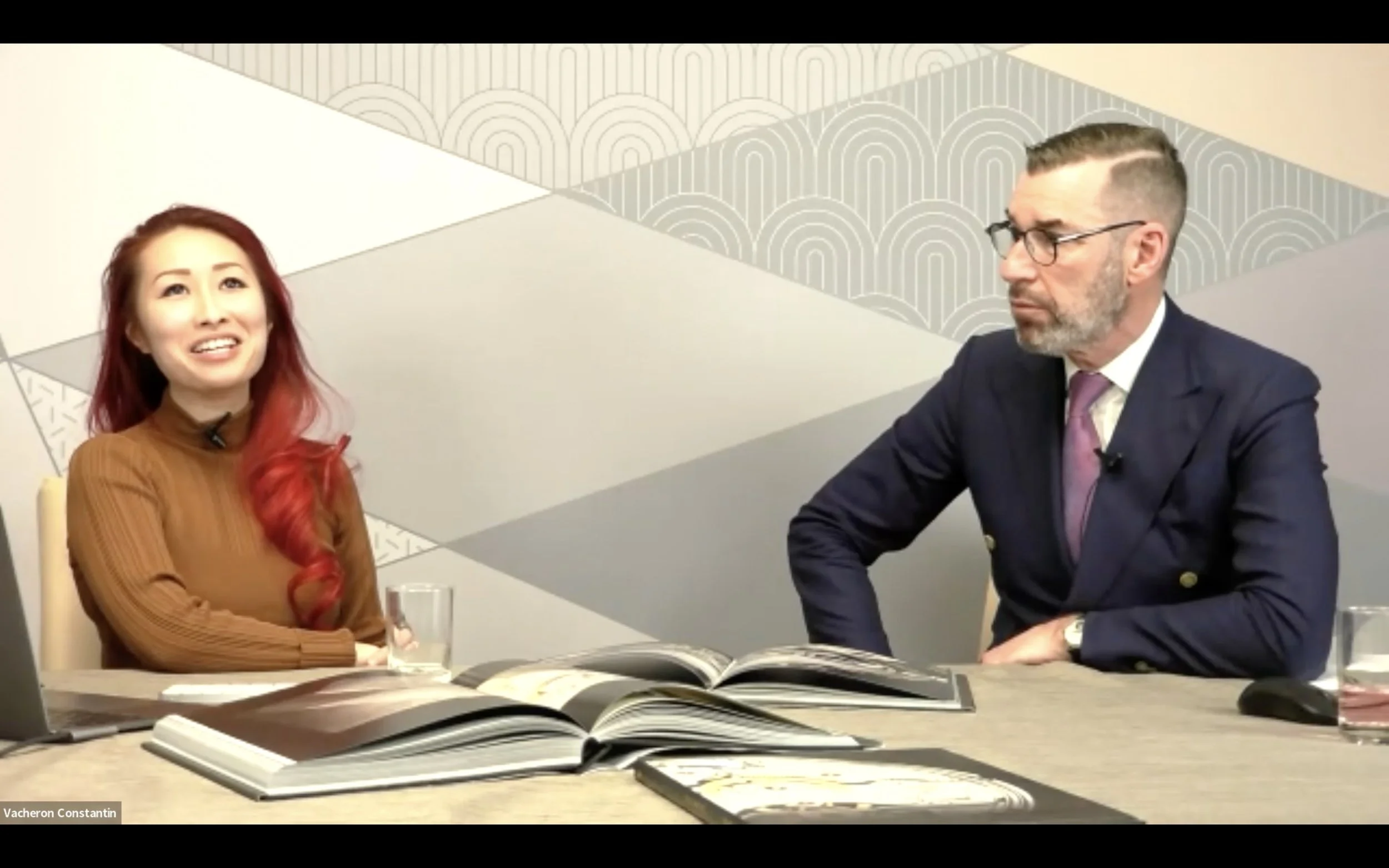

La France: Another Land of Watchmaking, by Colin de Tonnac
Colin de Tonnac, Watchmaker, CEO and Founder at Semper & Adhuc (Labouheyre, France)
HSNY's December 2022 lecture will take place in person at the General Society Library. Doors open at 6PM ET, lecture to begin at 7PM ET. RSVP is required.
Since the 1980s and in the general subconscious, watchmaking has been above all a Swiss affair. When we think of watches or of a watch-producing country, typical images of Lake Geneva, the Swiss flag or the snowy mountains of the Vallée de Joux immediately come to mind.
However, there is another neighboring country that produces fine timepieces as well: France.
For the final lecture of 2022, Colin de Tonnac, Watchmaker, CEO and Founder at Semper & Adhuc, will discuss the evolution of French watchmaking, focusing on events, anecdotes, innovations and flagship models that put France on the map as a serious watchmaking nation, including the revival it has experienced in recent years.
The lecture video will be available to members immediately, and to the general public following a two-month delay.
About Colin de Tonnac
After graduating in Paris and then Morteau watchmaking schools, Colin worked in a prestigious and independent family-owned manufacture in Geneva: Patek Philippe SA. First in the quality department, then as a lab technician in watchmaking, he kept on improving his abilities in elaborating, optimizing and assembling timekeepers. In August 2016, driven by a deep desire to set up his own business, he created the project of his dreams: Semper & Adhuc atelier, an elegant and durable watch production company creating new watches from restored old watch mechanisms.

The Development of an Icon of Modern Horology: The Freak, by Jean-Christophe Sabatier (with Special Guest)
Jean-Christophe Sabatier, Chief Product Officer at Ulysse Nardin (Le Locle, Switzerland)
Video recordings of lectures are available immediately to HSNY members, and the general public with a two-month delay.
HSNY's November 2022 lecture will take place in person at the General Society Library. Doors open at 6PM ET, lecture to begin at 7PM ET. RSVP is required.
The lecture video will be available to members immediately, and to the general public following a two-month delay.
The Freak by Ulysse Nardin is unique by name and by the promises it carries in terms of design and technical content. The Freak has seen many iterations since its inception in 2001, gathering inspiration from the ever-changing cosmos.
At the November 2022 lecture, Jean-Christophe Sabatier, Chief Product Officer at Ulysse Nardin, will share how the Freak has been a significant contributor in establishing the brand as an independent integrated manufacture. Sabatier will also discuss its history, cutting-edge components and more.
About Jean-Christophe Sabatier
Jean-Christophe Sabatier is head of the product department at Ulysse Nardin, in Le Locle. Responsible for the brand’s product range from design of new collections to market distribution, Jean-Christophe and his team draw up designs for new products, decide on their positioning, and help to keep the spirit of creativity and innovation going – values dear to the Maison. Jean-Christophe is a project management expert responsible for a team of ten people, including artists, designers and project managers.
With years of technical endeavors in automotive and sports industries under his belt, Jean Christophe entered the watchmaking sector in 2002 as marketing and communications director of Baume et Mercier. In 2011, he started at the Kering group, as director of the Watches sector at Boucheron. Finally, in March 2016, Jean-Christophe arrived at Ulysse Nardin as product director.
Special Guest: With twenty-five years at the bench under his belt, Ulysse Nardin’s Head Watchmaker Kris Endress joined the team in 2009 after being introduced to the Ulysse Nardin Freak a few years prior. Having fallen in love with the uniqueness of this piece, Endress turned down several offers from other companies to move his family to Switzerland to work for Ulysse Nardin.
With an affinity for technical content and creation, Sabatier and Endress have enjoyed working closely for the last six years continuing to revolutionize the art of horology at Ulysse Nardin.

The Changing Face of Early Modern Time, by Dr. Jane Desborough
Dr. Jane Desborough, Keeper of Science Collections at the Science Museum (London, England)
Video recordings of lectures are available immediately to HSNY members, and the general public with a two-month delay.
* HSNY's October 2022 lecture will take place in person in the General Society’s Assembly Room, located on the first floor of the building due to renovations in the General Society Library. Seating is limited and available via RSVP on a first-come-first-serve basis.
The lecture will also be livestreamed. RSVP is required. Doors open at 6PM ET, lecture and Zoom livestream to begin at 7PM ET.
Early modern clock and watch dials mirrored changes in the wider intellectual and cultural context of which they were inextricably a part. At the October 2022 lecture of the Horological Society of New York, Dr. Jane Desborough, Keeper of Science Collections at the Science Museum in London, will chart the significant changes that dials underwent in the period from 1550 to 1770, highlighting the many factors that eventually led to a more-or-less uniform design being adopted by 1770. This 220-year journey of development was a fascinating one in which different attributes of dial design were introduced to meet a particular user demand, such as the touch-pins which were added to help partially-sighted users and which were then discarded once alternative aids became available. It is, therefore, the discarded elements that did not secure a place on the uniform design that are the most interesting.
Multiple forms of lunar calendar and astronomical symbols, for example, were highly significant to both makers and users during the late-sixteenth and seventeenth centuries, but eventually either disappeared entirely or survived on only rare examples. Comparing dials with contemporary texts and diagrams enables us to identify the influences that led to these changes. Clock and watch makers of the past were after all inextricably part of the wider context of experiment, knowledge formation and exchange which characterised the early modern period. Highly literate, highly skilled and an integral part of wide-ranging & highly-connected networks, early modern clock and watch makers played an active role in disseminating, validating and discrediting ideas and practices. This was evident in their dial designs.
About Dr. Jane Desborough
Dr. Jane Desborough is Keeper of Science Collections at the Science Museum in London where she is responsible for the Museum’s Time Measurement Collection. She is author of The Changing Face of Early Modern Time, 1550-1770, based on her Ph.D. research, and co-author of Science City: Craft, Commerce & Curiosity in London 1550-1800.

The Quartz Crisis: A Tragic Decade for Swiss Watchmaking, by Hyla Ames Bauer
Hyla Ames Bauer, Watch and Jewelry Writer (New York, New York)
Video recordings of lectures are available immediately to HSNY members, and the general public with a two-month delay.
Note from the lecturer: Wear a Swatch if you have one!
In the early and mid-20th century, the Swiss watchmaking industry was booming — until the quartz crisis happened in the 1970s and shook it to its core.
At the September 2022 lecture of the Horological Society of New York (HSNY), watch and jewelry writer Hyla Ames Bauer will discuss the quartz crisis, beginning with what a quartz watch is, and why it's called a quartz watch and not a battery watch (or some other name). The lecture will also include an overview of how successful Swiss watchmaking was prior to the crisis, and how important it was to the Swiss economy. Bauer will describe the rapid development of quartz timepieces in Japan, at a time when the Swiss were just dipping their toes into quartz technology. Ultimately, in the mid-1970s, quartz watches became an inexpensive novelty that attracted millions of buyers. At that time, Swiss brands could not produce quartz watches at lower prices and the industry faltered. How many job losses occurred, and how many brands closed for good? Join us on September 7 as Bauer shares the facts on how Swiss brands were impacted and got back on their feet!
About Hyla Ames Bauer
Hyla Ames Bauer began her career as a fashion editor at Conde Nast Publications. After stints at GQ and Vogue, she became the Executive Fashion Editor of Conde Nast Traveler. Hyla fell in love with watches on her first trip to Basel while at Traveler. Hyla's passion for watches led her to seek a job in the industry, and she left Traveler to become the head of PR for Vacheron Constantin North America. After two years, Hyla returned to magazines as Editor in Chief of Watch Journal, where she oversaw a redesign of the magazine and its website. Hyla is currently a freelance writer in watches and fine jewelry.

The Genesis of the Royal Oak: From Iconoclast to Icon, by Sébastian Vivas
Sébastian Vivas, Heritage & Museum Director at Audemars Piguet (Le Brassus, Switzerland)
Video recordings of lectures are available immediately to HSNY members, and the general public with a 2 month delay.
In 2022, the Royal Oak watch is celebrating its 50th anniversary. In preparation for this event, the Audemars Piguet Heritage team spent a few years in the brand’s archives to better understand the history of this iconoclastic timepiece, which became a cultural icon within and beyond watchmaking.
This lecture will share the results of this ongoing research, while shedding light on the major actors involved in the watch’s creation, among whom are Italian agent Carlo de Marchi, designer Gérald Genta, and former CEO of Audemars Piguet Georges Golay. It will also pay tribute to the many people and companies that contributed to the timepiece’s challenging development: case-maker Favre-Perret, movement-maker LeCoultre & Cie, bracelet-maker Gay Frères and famous dial-maker Stern Frères.
At the June 6, 2022, lecture of the Horological Society of New York, Sébastian Vivas, Heritage & Museum Director at Audemars Piguet, will distinguish myth from reality in terms of the watch’s creation process as well as its reception, commercial success and extraordinary destiny.
About Sébastian Vivas
In 2001, Sébastian Vivas obtained his Master’s in Modern History at the University of Neuchâtel. He went on to publish the history of the Journal Suisse d’Horlogerie, a study awarded by the Fritz Kunz prize. From 2001 to 2012, Vivas served as Heritage Manager at Jaeger-LeCoultre, where he contributed to several exhibitions, publications and to the creation of the in-house museum, named the Heritage Gallery, inaugurated in 2007.
Since 2012, he has acted as Heritage & Museum Director at Audemars Piguet, where he oversees the study, structuring, preservation and communication of the brand’s heritage. He is assisted in this mission by a diverse team, which includes restoration watchmakers, historians and archivists.
Among his notable contributions, Vivas directed and co-authored the book Audemars Piguet 20th Century Complicated Wristwatches published in 2018, as well as the web platform APChronicles, launched in 2022. He also managed the project of the Musée Atelier Audemars Piguet, which opened its doors in 2020, and continues to curate its permanent and temporary exhibitions. Lastly, he has curated a variety of exhibitions for the brand, among which Beyond Watchmaking (Shanghai 2016, Tokyo 2019).

Hidden Figures: Overlooked Elements of Watchmaking, by Jeffrey Kingston
Jeffrey Kingston, Editor-in-Chief of Le Quai de l’Horloge (Sun Valley, Idaho)
Video recordings of lectures are available immediately to HSNY members, and the general public with a 2 month delay.
Many elements of a fine watch are often overlooked by connoisseurs or not given their full due. Free-sprung balances, silicon hairsprings, copper beryllium wheels, multiple mainspring barrels and secure calendar mechanisms all could be considered the "Hidden Figures" of watchmaking.
At the May 5, 2022, lecture of the Horological Society of New York, Jeffrey Kingston will discuss these elements and show the importance and value that they bring to horology.
About Jeffrey Kingston
Jeffrey Kingston is an author and frequent speaker on watchmaking. He has given talks throughout the United States, Europe, Asia and the Middle East. He is the Editor of Breguet’s magazine, Le Quai de l’Horloge. In a former life he was an anti-trust lawyer and was lead counsel in the proceedings against Microsoft in Brussels that led to the landmark judgement in 2004.

Next Generation NOMOS Movements: Thin, Automatic, and Highly Precise, by Theodor Prenzel
Theodor Prenzel, Head of Design Engineering at NOMOS Glashütte (Glashütte, Germany)
Martina Etti, Head of International Sales at NOMOS Glashütte & Co-CEO at NOMOS Glashütte Inc., New York (Glashütte, Germany)
Video recordings of lectures are available immediately to HSNY members, and the general public with a 2 month delay.
The NOMOS caliber DUW 3001 could be hidden from view behind a stack of nine postage stamps. At 3.2 millimeters in height, NOMOS’ caliber DUW 3001 is thinner than almost everything else in the world of watchmaking that self-winds and is produced in large-scale series — and yet it is still highly precise. The successive caliber DUW 6101 with patented date mechanism measures only 0.4 millimeters more. How was this even made possible?
At the March 2022 meeting of the Horological Society of New York, Theodor Prenzel, Head of Design Engineering at NOMOS Glashütte, will explain the new construction principle in comparison to classical construction principles in watchmaking. In addition to DUW 3001, the lecture will also explore DUW 6101 with a new, innovative mechanism and double-sided quick date adjustment.
About Theodor Prenzel
Born in 1984, Theodor Prenzel trained as a watchmaker at the Swatch Group, after which he worked as a watchmaker at Omega. He completed his studies in Precision Engineering at the Ernst Abbe University in Jena.
Theodor has been a Design Engineer at NOMOS Glashütte since 2013, and in 2014 he was promoted to Head of the Design Engineering and Deputy Head of R&D.

Vacheron Constantin’s Calendar Watches: An Exploration of Time & Space with Christian Selmoni and Suzanne Wong
Christian Selmoni, Vacheron Constantin Style & Heritage Director (Geneva, Switzerland)
Suzanne Wong, Editor-in-Chief, WorldTempus (Geneva, Switzerland)
Video recordings of lectures are available immediately to HSNY members, and the general public with a 2 month delay.
Beyond seconds, hours and minutes, the calendar organizes our days, weeks and months. With that in mind, it makes sense that calendars were among the earliest complications added to clocks and watches. Understanding the calendar complication can lead to a deeper understanding of what makes a mechanical watch tick, and the effort that goes into designing and manufacturing them.
At the February 2022 meeting of the Horological Society of New York, Vacheron Constantin Heritage & Style Director Christian Selmoni will explore the very notion of time through the medium of calendar watches. Join Selmoni for a deep dive into the stories behind the Maison’s calendar watches and their roots in astronomy. Watch journalist Suzanne Wong will join Selmoni in uncovering the innovations Vacheron Constantin has developed in this field through timepieces such as Celestia, Planetaria and more.
About Christian Selmoni
Born in 1959 to a Swiss family of watchmakers in the Vallée de Joux, one of the historical birthplaces of watchmaking, Christian Selmoni serves as Style and Heritage Director at Vacheron Constantin.
Christian joined Vacheron Constantin in 1990 as Sales Administration Manager, becoming Purchasing Manager in 1992, and Production & Purchasing Director in 1996, during which time he played a key role in overseeing all aspects of manufacturing and sourcing.
In 2001, he was tasked with incorporating all product-creation aspects of Vacheron Constantin – from concept to final prototypes and product launch – into a unique Product Department, notably responsible for the design and development of the company’s famous 250th anniversary elements.
Christian was appointed Artistic Director at Vacheron Constantin in 2010, with responsibilities including the long-term definition of products and future “product” tendencies for the Maison; its creative aspects as well as the development and consolidation of the Métiers d’Art workshops (artistic crafts such as enamel, engraving, gem-setting and guillochage), together with Les Cabinotiers workshop which includes design and development of made-to-order timepieces.
In 2017, Christian was appointed Style and Heritage Director. Within the Heritage department, his main responsibilities are to enrich and develop the Maison’s heritage, as well as to extract designs and design elements from the past to nurture Vacheron Constantin’s present and future creations. In addition, he consolidates and develops relationship with international press, clients and watch collectors.
About Suzanne Wong
Suzanne Wong is a veteran watch journalist, born and raised in Singapore, one of the world’s most influential and mature watch markets. Her experience — which includes four years as editor-in-chief of Revolution magazine’s original flagship Asia edition and her current position as editor-in-chief of online media WorldTempus — spans both print and digital publishing and ranges from directing editorial strategy to creating compelling watch-related content.
At the heart of Suzanne’s work is the passion for furthering appreciation of fine mechanical watchmaking on a worldwide level. Her commitment to building relationships within the Swiss watch industry, allowing her to create stories that better reflect its core values, led her to relocate to Geneva in 2017, where she is now based.
Suzanne has been a member of the Cultural Council of the Fondation de la Haute Horlogerie since 2017, served three years on the jury of the prestigious Grand Prix d’Horlogerie de Genève (GPHG), is part of the pioneer cohort of the GPHG Academy, and is the co-founder of Watch Femme, a non-profit association dedicated to advancing women’s voices in the watch world.

Bvlgari Masterpieces: Chiming Watches with Fabrizio Buonamassa
Fabrizio Buonamassa, Bvlgari Product Creation Executive Director of Timepieces (Neuchâtel, Switzerland)
Video recordings of lectures are available immediately to HSNY members, and the general public with a 2 month delay.
Bvlgari has established itself as the Master of the Estetica della Meccanica, balancing savoir-faire and the innovative aesthetics of ultra-thin watches to create groundbreaking timepieces. This expression of the fusion between cutting-edge design and the technical expertise of Swiss watchmaking is an exercise of the highest complexity, seen in Bvlgari’s mastery of highly complicated watches, including the whole typology of chiming timepieces: 2, 3 and 4 hammers, from the Octo Finissimo Minute Repeater to the Octo Roma Grande Sonnerie.
In 2021 Bvlgari explored a new facet of its Estetica della Meccanica inspiration, creating another Sinfonia della Meccanica with the Octo Roma Carillon Tourbillon. Join Fabrizio Buonamassa, Bvlgari Product Creation Executive Director of Timepieces, at the January 2022 meeting of the Horological Society of New York as he shares an up-close look at Bvlgari’s chiming masterpieces.
HSNY’s January lecture will be streamed live via Zoom. All HSNY lectures are free and open to the public. RSVP is required.
About Fabrizio Buonamassa
Born in Naples in 1971, Fabrizio Buonamassa studied Industrial Design at the “Istituto Superiore Industrie Artistiche” in Rome.
He began his career at the Centro Stile Fiat in Turin. During this experience, he managed highly complex projects both in terms of style and manufacturing.
In 2001, driven by the desire to face new challenges and by his lifelong passion for watches, he sent some of his designs to the Bvlgari Design Center in Rome. A short time later Mr. Paolo Bvlgari, CEO and creative driver of the brand, invited Fabrizio to Rome to join the Watches Design team.
In 2007 he was appointed Bvlgari Watches Design Center Director, where his mission is to constantly reinterpret Bvlgari's rich stylistic and cultural heritage in a contemporary language in tune with the brand's DNA.
In 2011 Fabrizio moved the Watches Design Center to Neuchâtel in order to be closer to the heart of watchmaking and to better manage the high level of complexity related to the Bvlgari timepieces’ creation and craftsmanship. Today his contribution within the brand is not only related to watches but also to other product categories, thus he has been recently appointed Bvlgari Product Creation Executive Director.




























